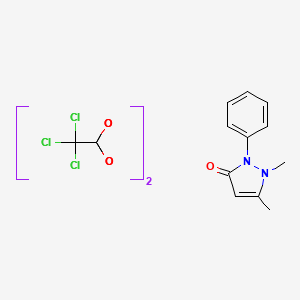Attribution Statement: LactMed is a registered trademark of the U.S. Department of Health and Human Services.
NCBI Bookshelf. A service of the National Library of Medicine, National Institutes of Health.
Drugs and Lactation Database (LactMed®) [Internet]. Bethesda (MD): National Institute of Child Health and Human Development; 2006-.
CASRN: 480-30-8

Drug Levels and Effects
Summary of Use during Lactation
Short-term or occasional use of dichloralphenazone during breastfeeding is unlikely to adversely affect the breastfed infant, especially if the infant is older than 2 months. Because the active metabolite, trichloroethanol, has a long half-life, long-term use of repeated doses during breastfeeding could result in infant sedation, especially while nursing a neonate or preterm infant. The low doses of dichloralphenazone found in combination migraine products (e.g., Midrin) are less likely to cause drowsiness in the infant unless doses are repeated several times daily. The antipyrine component of dichloralphenazone is considered unlikely to harm the infant.[1,2] Monitor the infant for sedation, poor feeding and poor weight gain.
Drug Levels
Dichloralphenazone is a chemical combination of chloral hydrate (64%) and antipyrine (36%).
Maternal Levels. After 1.3 grams of dichloralphenazone (equivalent to about 830 mg of chloral hydrate) daily in a woman who was 5 months postpartum, milk trichloroethanol levels were found to range from 1.3 to 3.2 mg/L.[3]
Antipyrine was given to 7 lactating women were 2 to 19 months postpartum. Each woman drank a single oral dose of 18 mg/kg of antipyrine in solution. Peak milk levels usually occurred 10 minutes after ingestion and ranged from about 10 to 30 mg/L. The antipyrine half-life in milk averaged 11.6 hours (range 5.7 to 21.7 hours). The authors estimated that a fully breastfed infant would ingest 6.4 mg of antipyrine after this maternal dose or 0.59% of the maternal dose (not weight-adjusted). Two of the women who were studied before and after pregnancy indicated that antipyrine clearance might be increased by about two-fold during lactation.[1] The time course of antipyrine appearance in milk is probably slower than above from dichloralphenazone in a tablet formulation.
Infant Levels. After a 1.3 gram maternal dose of dichloralphenazone (equivalent to about 1 gram of chloral hydrate), trichloroethanol was detected in her 5-month-old breastfed infant's plasma 21 hours later.[3]
Effects in Breastfed Infants
Minimal morning sedation occurred in a 5-month-old breastfed infant whose mother was taking 1.3 grams of dichloralphenazone (equivalent to about 1 gram of chloral hydrate) every evening plus chlorpromazine 100 mg 3 times daily. The infant's overall development was said to be normal at 3 months of age.[3]
Effects on Lactation and Breastmilk
Relevant published information was not found as of the revision date.
Alternate Drugs to Consider
References
- 1.
- Berlin CM Jr, Vesell S. Antipyrine disposition in milk and saliva of lactating women. Clin Pharmacol Ther. 1982;31:38–44. [PubMed: 7053302]
- 2.
- Reed CB. A study of the conditions that require removal of the child from the breast. Surg Gynecol Obstet. 1908;6:514–27.
- 3.
- Lacey JH. Dichloralphenazone and breast milk. Br Med J. 1971;4:684. [Letter] [PMC free article: PMC1799850] [PubMed: 5134581]
Substance Identification
Substance Name
Dichloralphenazone
CAS Registry Number
480-30-8
Drug Class
Breast Feeding
Milk, Human
Anti-Inflammatory Agents, Non-Steroidal
Hypnotics and Sedatives
Disclaimer: Information presented in this database is not meant as a substitute for professional judgment. You should consult your healthcare provider for breastfeeding advice related to your particular situation. The U.S. government does not warrant or assume any liability or responsibility for the accuracy or completeness of the information on this Site.
- User and Medical Advice Disclaimer
- Drugs and Lactation Database (LactMed) - Record Format
- LactMed - Database Creation and Peer Review Process
- Fact Sheet. Drugs and Lactation Database (LactMed)
- Drugs and Lactation Database (LactMed) - Glossary
- LactMed Selected References
- Drugs and Lactation Database (LactMed) - About Dietary Supplements
- Breastfeeding Links
- PMCPubMed Central citations
- PubChem SubstanceRelated PubChem Substances
- PubMedLinks to PubMed
- Review Chloral Hydrate.[Drugs and Lactation Database (...]Review Chloral Hydrate.. Drugs and Lactation Database (LactMed®). 2006
- Review Antipyrine.[Drugs and Lactation Database (...]Review Antipyrine.. Drugs and Lactation Database (LactMed®). 2006
- Review Clorazepate.[Drugs and Lactation Database (...]Review Clorazepate.. Drugs and Lactation Database (LactMed®). 2006
- Review Dimenhydrinate.[Drugs and Lactation Database (...]Review Dimenhydrinate.. Drugs and Lactation Database (LactMed®). 2006
- Review Diazepam.[Drugs and Lactation Database (...]Review Diazepam.. Drugs and Lactation Database (LactMed®). 2006
- Dichloralphenazone - Drugs and Lactation Database (LactMed®)Dichloralphenazone - Drugs and Lactation Database (LactMed®)
Your browsing activity is empty.
Activity recording is turned off.
See more...
